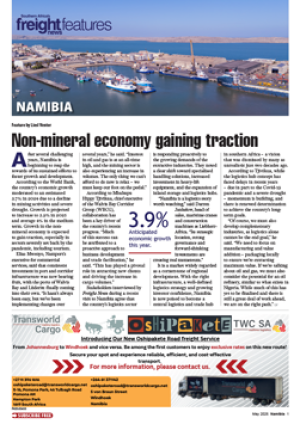TRADE FROM Asia to South Africa is growing at
a rate of 20-22% a year and all indications point
to more of the same for the year ahead, says
Safmarine’s Peter H. Ehrenreich.
Speaking to FTW from Hong Kong recently, the
regional senior executive for the Far East & Oceania
painted a bullish trade picture with Safmarine well
placed to tap into the growing market, particularly
from Mainland China.
Ehrenreich heads up Safmarine’s activities in
Japan, South Korea, Mainland China, Hong Kong,
Taiwan, Philippines, Vietnam, Thailand, Singapore,
Malaysia, Indonesia and Australia and is based in
Singapore with a regional office comprising 16 team
members.
“For most shipping lines covering the whole
Asian range, business from Mainland China makes
up around 70% of their revenue and volume – and
Safmarine is no different," says Ehrenreich.
“But we’ve also seen huge expansion in
Indonesia, Vietnam, Thailand and South Korea,”
he added. “Profitable growth together with our
customers is our aim. We are five times as big as
when I came here in 2003 and after Europe, Asia is
now the second largest of Safmarine’s five regions.
“We now have 11 dedicated Safmarine offices
employing 140 people in Mainland China alone. All
the other Asian countries have also seen impressive
growth.”
The emergence of the Mainland has not been
particularly positive for Hong Kong, with a lot more
direct traffic now moving straight to and from
Mainland China. “That has translated into far less
transhipment traffic for Hong Kong which last year,
for the first time, did not see significant growth in
volumes.
“Since Mainland China joined the World
Trade Organisation it’s much easier to establish
a company there and get the licences required
to work. And Hong Kong is not a cheap place to
tranship. It makes good business sense to call at the
Mainland’s ports directly.”
But in terms of efficiency, there’s no disputing
its rank. “A lot of cargo arrives on barges and some
handling in port is done midstream without docking.
Containers are stacked very high, which creates
some challenges in typhoon season, but operations
are extremely efficient.
“They have far less space available than for
instance Durban – but Hong Kong handles 10 times
the volume of Durban.”
Ehrenreich however predicts that Shanghai will
soon be a bigger container port than Hong Kong
and Singapore, with Shenzhen second.
And one of its trump cards is its inland
infrastructure, with government investment keeping
pace with industry demand.
But while the westbound route continues its
upward spiral, exports to the east remain limited.
“From South Africa it’s usually low-value, heavy
duty commodities like copper, other minerals, starch,
paper and some wine. There is also much fruit
shipped to Asia but it has traditionally been shipped
palletised in reefer ships.
“This will increasingly be shipped in refrigerated
containers and Safmarine will assist the stakeholders
in this inevitable transition. We have been through
the same conversion in so many other markets and
this one is right in front of us,” Ehrenreich said.
‘Shanghai will soon overtake Hong Kong as trade growth escalates’
26 Oct 2007 - by Staff reporter
0 Comments
